Self-Healing Thermal-Reversible Low-Temperature Polyurethane Powder Coating Based on Diels–Alder Reaction
Abstract
1. Introduction
- (1)
- Upon the cracks being formed on a microscopic scale, healing may be achieved by forming a network through the discharge of crosslinks formed between the diene and dienophile in that place. As the temperature increases (around 120–160 °C), the equilibrium reaction shifts from the side of DA bonds formed toward the breaking of these bonds, which leads to an increase in molecular mobility and a higher concentration of active diene and dienophile groups. At a certain temperature, the contact between the cracked surfaces is facilitated by decreasing the crosslinking density, which in turn helps to close the microscopic cavities.
- (2)
- The sample is annealed to the temperature required for the DA reaction and retrieval of bonds to form a DA moiety. Since the crosslinks are formed through an equilibrium reaction between a diene and dienophile and the formation of a DA linkage is exothermic, upon the temperature decrease (50–70 °C), the equilibrium shifts to the reversed direction, i.e., the more bonded state, and as a result, dynamic covalent crosslinks are formed at the crack interface during the [4 + 2] cycloaddition DA reaction. Thus, this process can be repeated at a suitable and effective temperature until the crack is filled [19,20].
2. Experimental Section
2.1. Reagents
2.2. Synthesis of Acrylic Resin
2.3. Synthesis of Blocked Polyisocyanates (bPICs)
2.4. Preparing Self-Healing Powder Coating Composition and Coatings
3. Characteristics of the Methods Used
3.1. Nuclear Magnetic Resonance Spectroscopy (NMR)
3.2. Differential Scanning Calorimetry (DSC)
3.3. FT-IR Measurements
3.4. Polarized Optical Microscopy
3.5. Thermogravimetric Analysis (TGA)
3.6. Polymerization Test
- Coating appears matte and soft;
- Coating appears matte and can be scratched with a nail;
- Slight gloss reduction;
- No noticeable changes.
3.7. Flow Test
3.8. Roughness
3.9. Thickness and Gloss
3.10. Adhesion to Steel
3.11. Hardness
3.12. Scratch Resistance
3.13. Cupping
3.14. Water Contact Angle (WCA)
4. Results and Discussion
4.1. Characterization of Acrylic Resin and bPICs
4.1.1. Acrylic Resin
4.1.2. Blocked Polyisocyanates (bPICs)
4.2. Curing Process and Self-Healing Properties of Powder Coatings
4.3. Characterization of Powder Coatings
5. Conclusions
Author Contributions
Funding
Institutional Review Board Statement
Informed Consent Statement
Data Availability Statement
Acknowledgments
Conflicts of Interest
References
- Directive 2004/42/EC of the European Parliament and of the Council of April 21, 2004 on the Limitation of Emissions of Volatile Organic Compounds Due to the Use of Organic Solvents in Certain Paints and Varnishes and Vehicle Refinishing Products, and Amending Directive 1999/13/EC; European Parliament: Strasbourg, France, 2004.
- Directive 2000/60/EC of the European Parliament and of the Council of 23 October 2000 Establishing a Framework for Community Action in the Field of Water Policy, Document 32000L0060. Available online: https://eur-lex.europa.eu/eli/dir/2000/60/oj (accessed on 1 July 2024).
- Jones, F.N.; Nichols, M.E.; Pappas, S.P. Organic Coatings: Science and Technology; Wiley: New York, NY, USA, 2017. [Google Scholar]
- Tassel, X.; Barbry, D.; Tighzert, L. A New Blocking Agent of Isocyanates. Eur. Polym. J. 2000, 36, 1745–1751. [Google Scholar] [CrossRef]
- Lv, X.; Zhang, H.; Zhang, H.; Shao, Y.; Zhu, J. Nanosized curing catalyst via nano-templated plasma PVD for attaining superior low-cure powder coating films. Prog. Org. Coat. 2024, 192, 108499. [Google Scholar] [CrossRef]
- Czachor-Jadacka, D.; Pilch-Pitera, B. Progress in Development of UV Curable Powder Coatings. Prog. Org. Coat. 2021, 158, 106355. [Google Scholar] [CrossRef]
- Pojnar, K.; Pilch-Pitera, B.; Roś, N.; Florczak, Ł. Low-temperature powder paint modified with graphene oxide. Ochr. Przed Koroz. 2024, 67, 30–39. [Google Scholar] [CrossRef]
- Pojnar, K.; Pilch-Pitera, B.; Kisiel, M.; Zioło, A.; Kędzierski, M. UV-cured powder transparent coatings based on oligo(meth)acrylic resins. Polimery 2024, 69, 11–24. [Google Scholar] [CrossRef]
- Pojnar, K.; Pilch-Pitera, B.; Patil, R. Progress in the development of acrylic resin-based powder coatings—An overview. Polimery 2024, 3, 143–158. [Google Scholar] [CrossRef]
- Path, U.; Schwalm, R.; Schwalm, M. Acrylic Resin; Vincentz Network GmbH & Co. KG: Hanover, Germany, 2011. [Google Scholar]
- Zhou, Z.; Xu, W.; Fan, J.; Ren, F.; Xu, C. Synthesis and characterization of carboxyl group-containing acrylic resin for powder coatings. Prog. Org. Coat. 2008, 62, 179–182. [Google Scholar] [CrossRef]
- Guo, X.; Ge, S.; Wang, J.; Zhang, X.; Zhang, T.; Lin, J.; Zhao, C.X.; Wang, B.; Zhu, G.; Guo, Z. Waterborne acrylic resin modified with glycidyl methacrylate (GMA): Formula optimization and property analysis. Polymer 2018, 143, 155. [Google Scholar] [CrossRef]
- Pojnar, K.; Pilch-Pitera, B. Correlation between the Chemical Structure of (Meth)Acrylic Monomers and the Properties of Powder Clear Coatings Based on the Polyacrylate Resins. Materials 2024, 17, 1655. [Google Scholar] [CrossRef] [PubMed]
- Gedan-Smolka, M.; HäEuûler, L.; Fischer, D. Thermal deblocking of masked low molecular isocyanates I. Aliphatic isocyanates. Thermochimica Acta 2000, 351, 95–105. [Google Scholar] [CrossRef]
- Sonnenschein, M. Introduction to polyurethane chemistry. In Polyurethanes: Science, Technology, Markets, and Trends; ACS Publications: Washington, DC, USA, 2014. [Google Scholar]
- Pilch-Pitera, B.; Kisiel, M.; Gumieniak, J. Hydrophobic UV-Curable Powder Clear Coatings: Study on the Synthesis of New Crosslinking Agents Based on Raw Materials Derived from Renewable Sources. Materials 2021, 14, 4710. [Google Scholar] [CrossRef] [PubMed]
- Gandini, A. The furan/maleimide Diels–Alder reaction: A versatile click–unclick tool in macromolecular synthesis. Prog. Polym. Sci. 2013, 38, 1–29. [Google Scholar] [CrossRef]
- Karami, Z.; Zolghadr, M.; Zohuriaan-Mehr, M.J. Self-healing Diels–Alder engineered thermosets. In Self-Healing Polymer-Based Systems; Elsevier: Amsterdam, The Netherlands, 2020. [Google Scholar]
- Ren, J.; Dong, X.; Duan, Y.; Lin, L.; Xu, X.; Shi, J.; Jia, R.; Wu, D.; He, X. Synthesis and self-healing investigation of waterborne polyurethane based on reversible covalent bond. J. Appl. Polym. Sci. 2022, 139, 52144. [Google Scholar] [CrossRef]
- Motora, K.G.; Wu, C.M.; Chang, C.C.; Liao, J.H. NIR Light Stimulated Self-Healing Reduced Tungsten Oxide/Polyurethane Nanocomposite Based on the Diels−Alder Reaction. Macromolar Mater. Eng. 2021, 306, 2100438. [Google Scholar] [CrossRef]
- Farshchi, N.; Gedan-Smolka, M.; Stommel, M. Preparation and Characterization of Self-Healing Polyurethane Powder Coating Using Diels–Alder Reaction. Polymers 2021, 13, 3803. [Google Scholar] [CrossRef] [PubMed]
- Pojnar, K.; Pilch-Pitera, B.; Byczyński, Ł.; Zając, W.; Walczak, M.; Kramek, A. Polyacrylate resins containing fluoroalkyl groups for powder clear coatings. Prog. Org. Coat. 2022, 172, 107116. [Google Scholar] [CrossRef]
- Qualicoat. Specifications for a Quality Label for Liquid and Powder Organic Coatings on Aluminium for Architectural Applications, 16th ed.; Qualicoat: Zurich, Switzerland, 2019. [Google Scholar]
- PN-EN ISO 8130-11; Coating Powders—Part 11: Inclined-Plane Flow Test. ISO: Geneva, Switzerland, 2019.
- PN-EN ISO 12085; Geometrical Product Specifications (GPS)—Surface Texture: Profile Method—Part 2: Terms, Definitions and Surface Texture Parameters. ISO: Geneva, Switzerland, 2018.
- PN-EN ISO 2813; Paints and Varnishes—Determination of Specular Gloss of Non-Metallic Paint Films at 20 Degrees, 60 Degrees and 85 Degrees. ISO: Geneva, Switzerland, 2014.
- PN-EN ISO 2808; Paints and Varnishes—Determination of Film Thickness. ISO: Geneva, Switzerland, 2019.
- PN-EN ISO 2409; Paints and Varnishes—Cross-Cut Test. ISO: Geneva, Switzerland, 2013.
- PN-EN ISO 1522; Paints and Varnishes—Pendulum Damping Test. ISO: Geneva, Switzerland, 2011.
- PN-EN ISO 1518; Paints and Varnishes—Scratch Hardness Tests—Part 1: Constant-Loading Method. ISO: Geneva, Switzerland, 2016.
- PN-EN ISO 1520; Paints and Varnishes—Cupping Test. ISO: Geneva, Switzerland, 2019.
- PN-EN ISO 19403-6:2020-08; Paints and Varnishes—Wetting—Part 3: Determination of Surface Tension of Liquids by the Hanging Drop Method. ISO: Geneva, Switzerland, 2020.
- Czachor-Jadacka, D.; Pilch-Pitera, B.; Byczyński, Ł.; Kisiel, M.; Zioło, A. Hydrophobic polyurethane powder clear coatings with lower curing temperature: Study on the synthesis of new blocked polyisocyanates. Prog. Org. Coat. 2021, 159, 106402. [Google Scholar] [CrossRef]
- Prabhakar, A.; Chattopadhyay, D.K.; Jagadeesh, B.; Raju, K.V.S.N. Structural investigations of polypropylene glycol (PPG) and isophorone diisocyanate (IPDI)-based polyurethane prepolymer by 1D and 2D NMR spectroscopy. J. Polym. Sci. Part A Polym. Chem. 2005, 43, 1196–1209. [Google Scholar] [CrossRef]
- Trivedi, M.K.; Tallapragada, R.M.; Branton, A.; Trivedi, D.; Nayak, G.; Mishra, R.K.; Jana, S. Characterization of Physical, Spectral and Thermal Properties of Biofield Treated 1,2,4-Triazole. Mol. Pharm. Org. Process Res. 2015, 3, 1000128. [Google Scholar] [CrossRef]
- Czachor-Jadacka, D.; Pilch-Pitera, B.; Kisiel, M.; Thomas, J. Polyurethane powder coatings with low curing temperature: Research on the effect of chemical structure of crosslinking agent on the properties of coatings. Prog. Org. Coat. 2023, 182, 107662. [Google Scholar] [CrossRef]

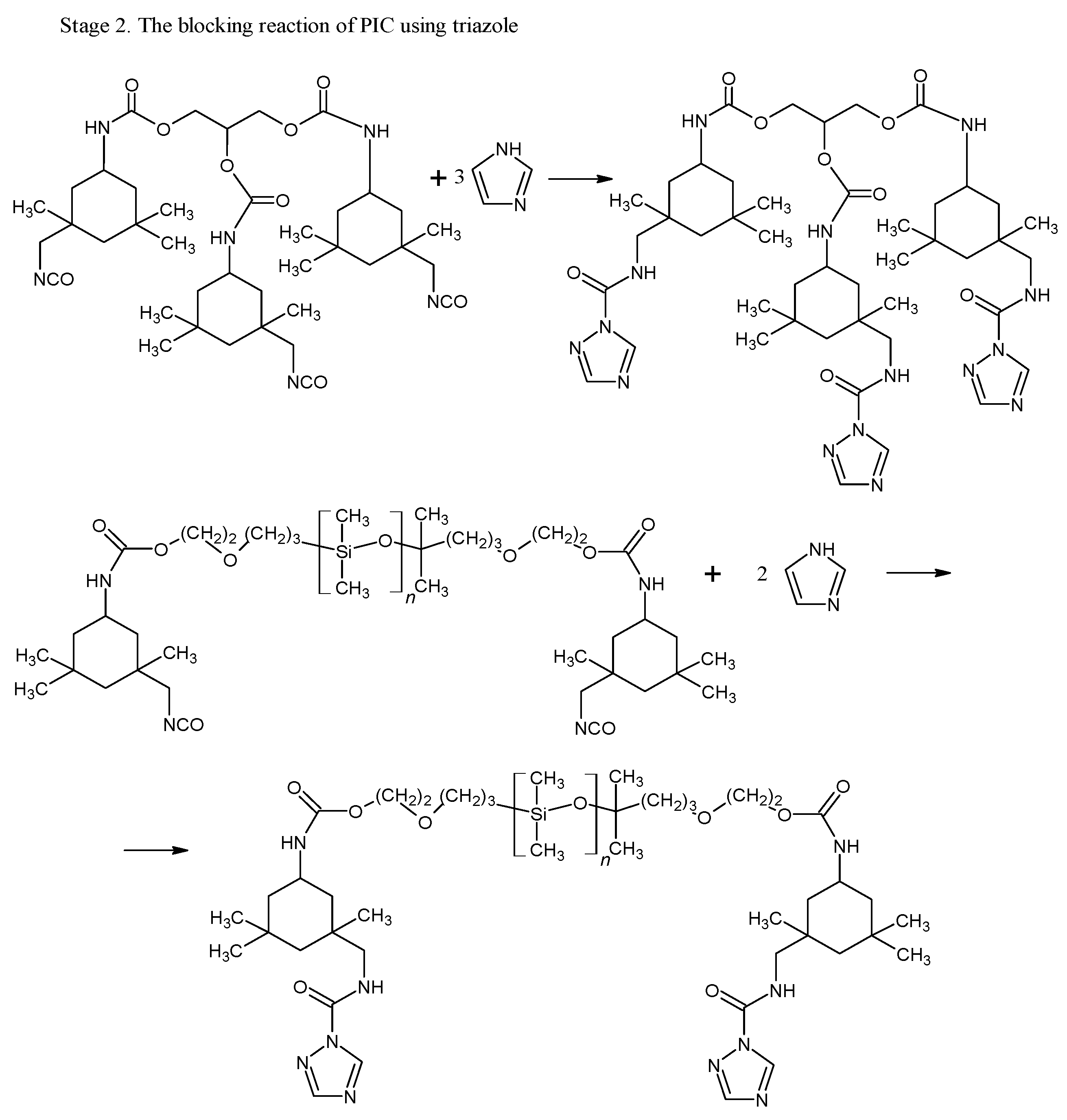
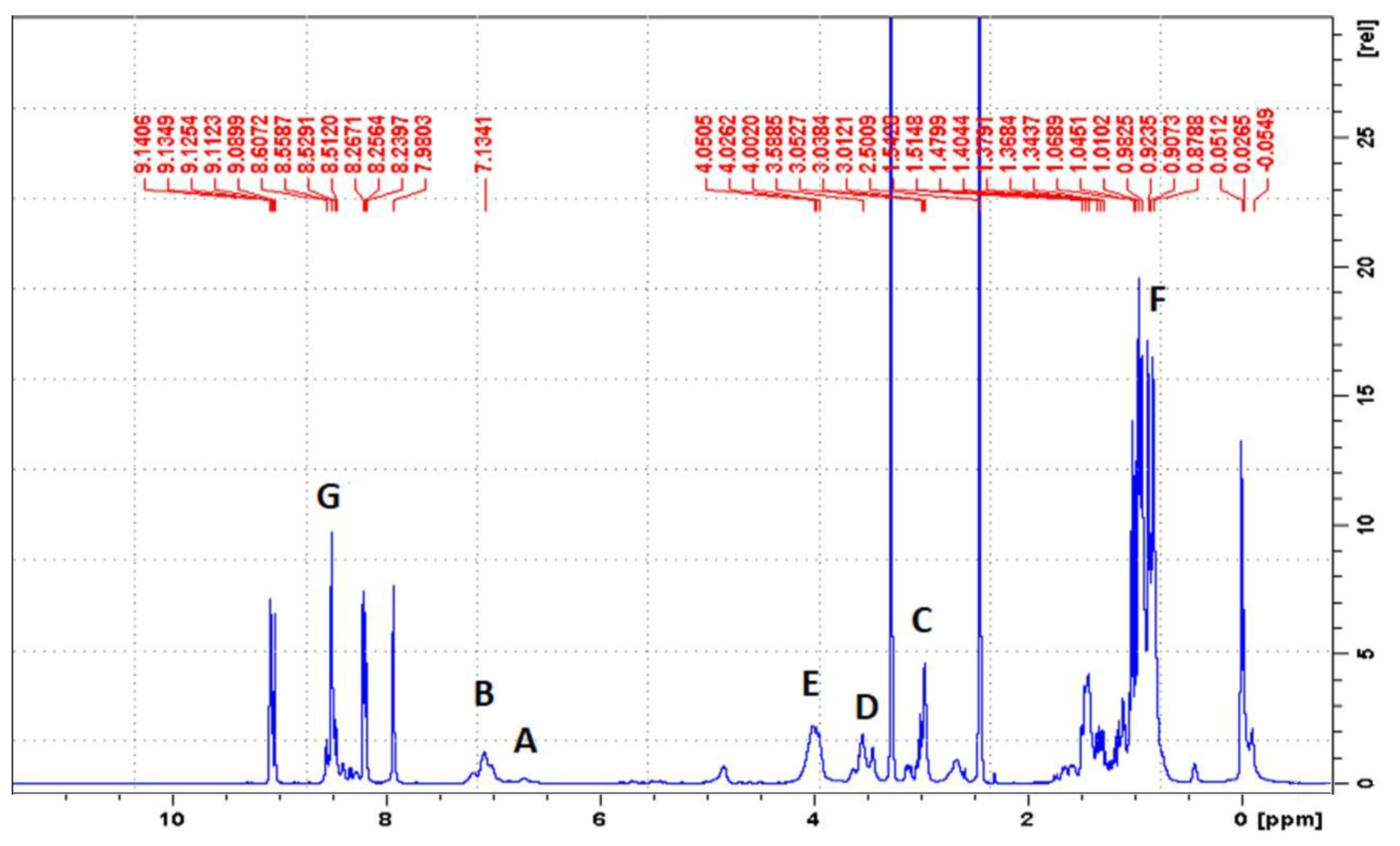
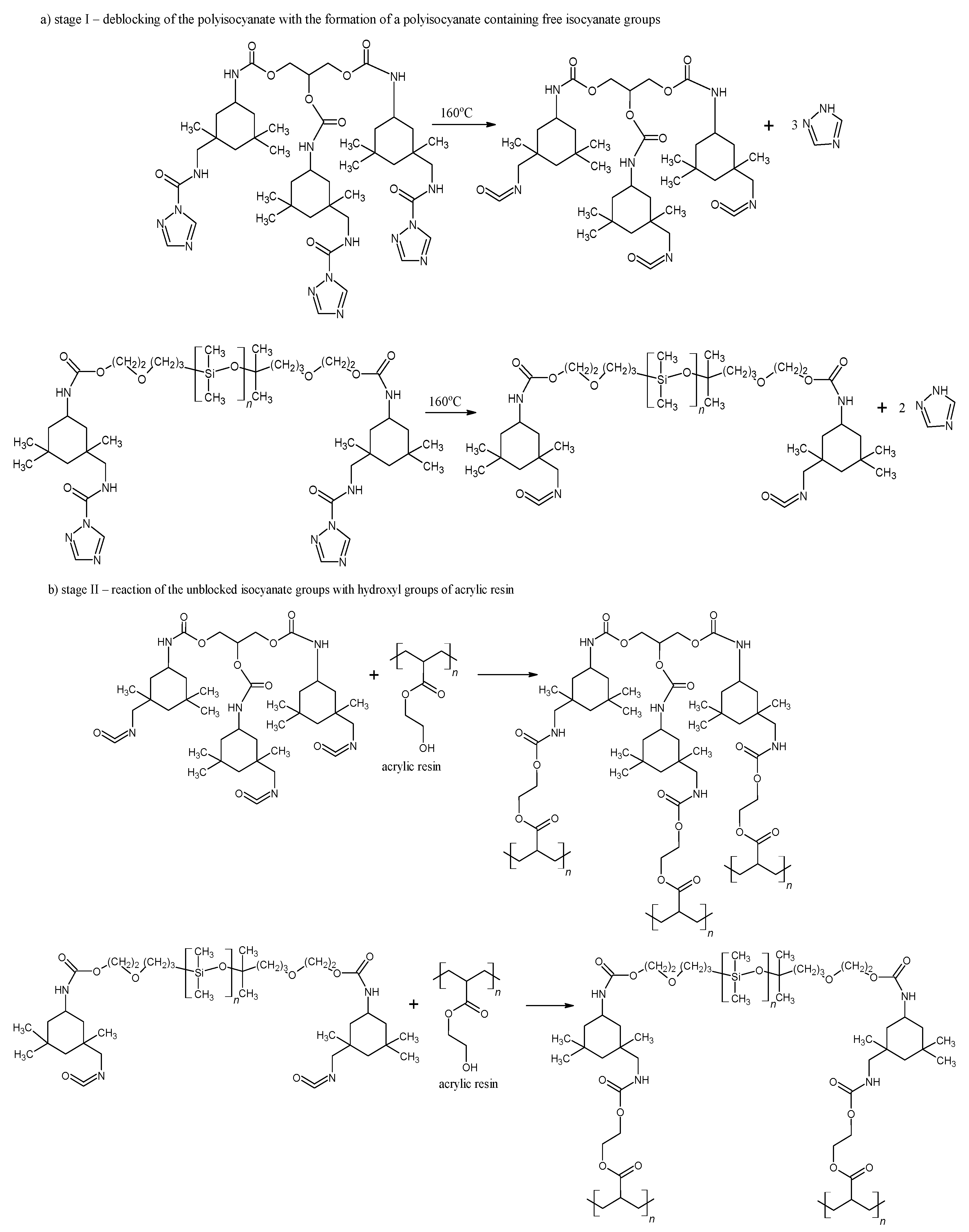
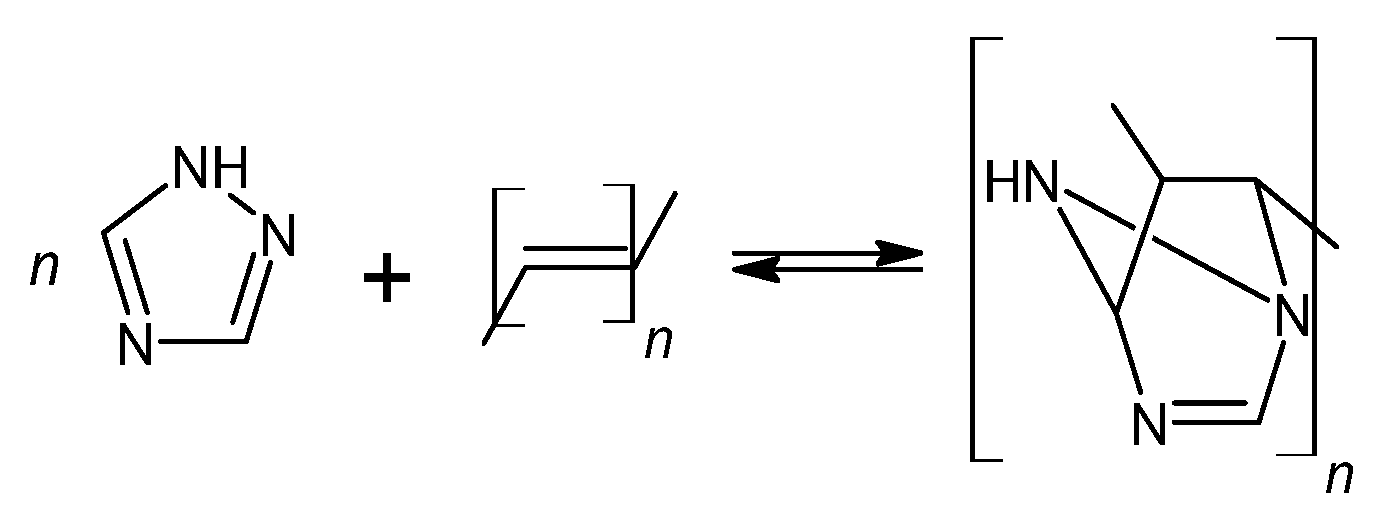
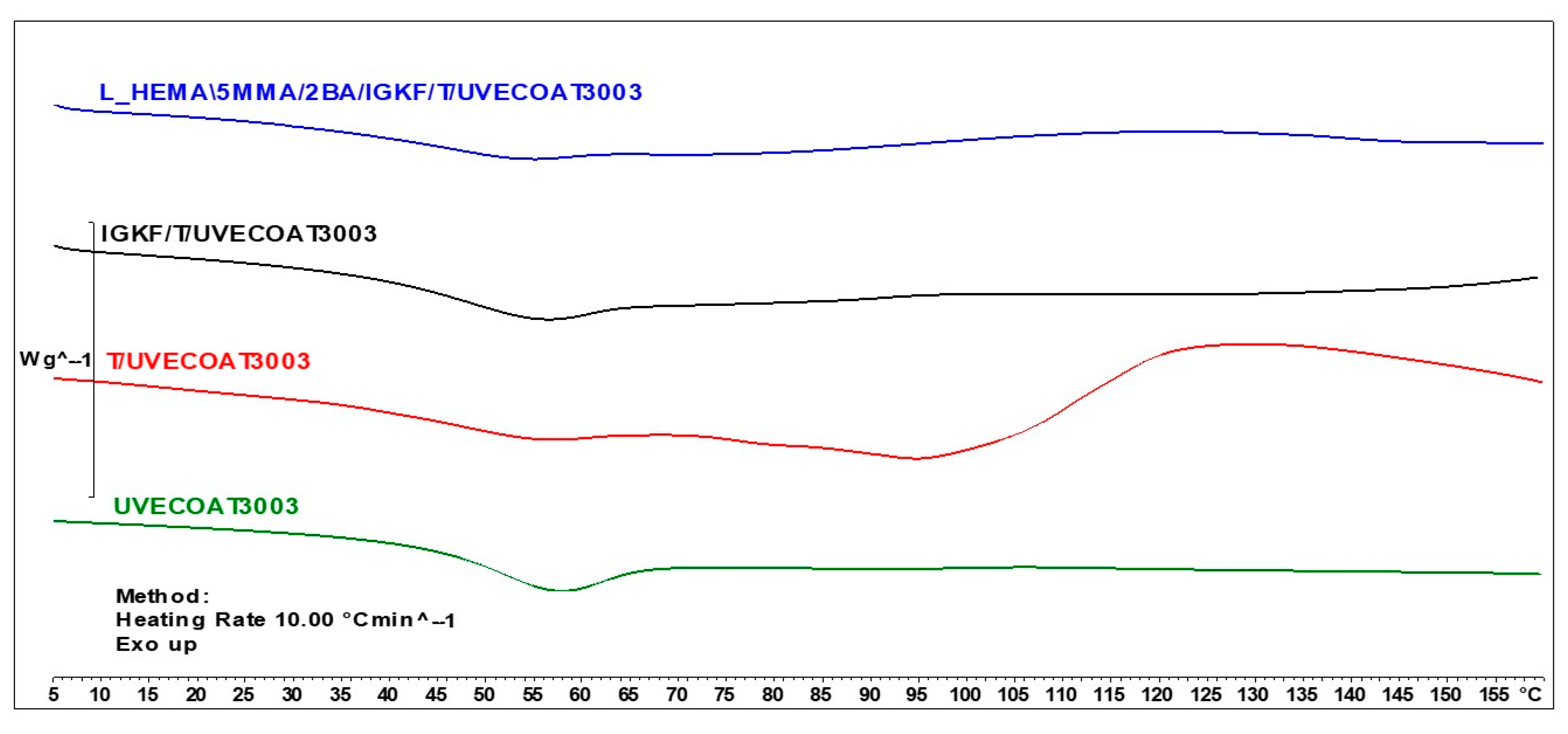
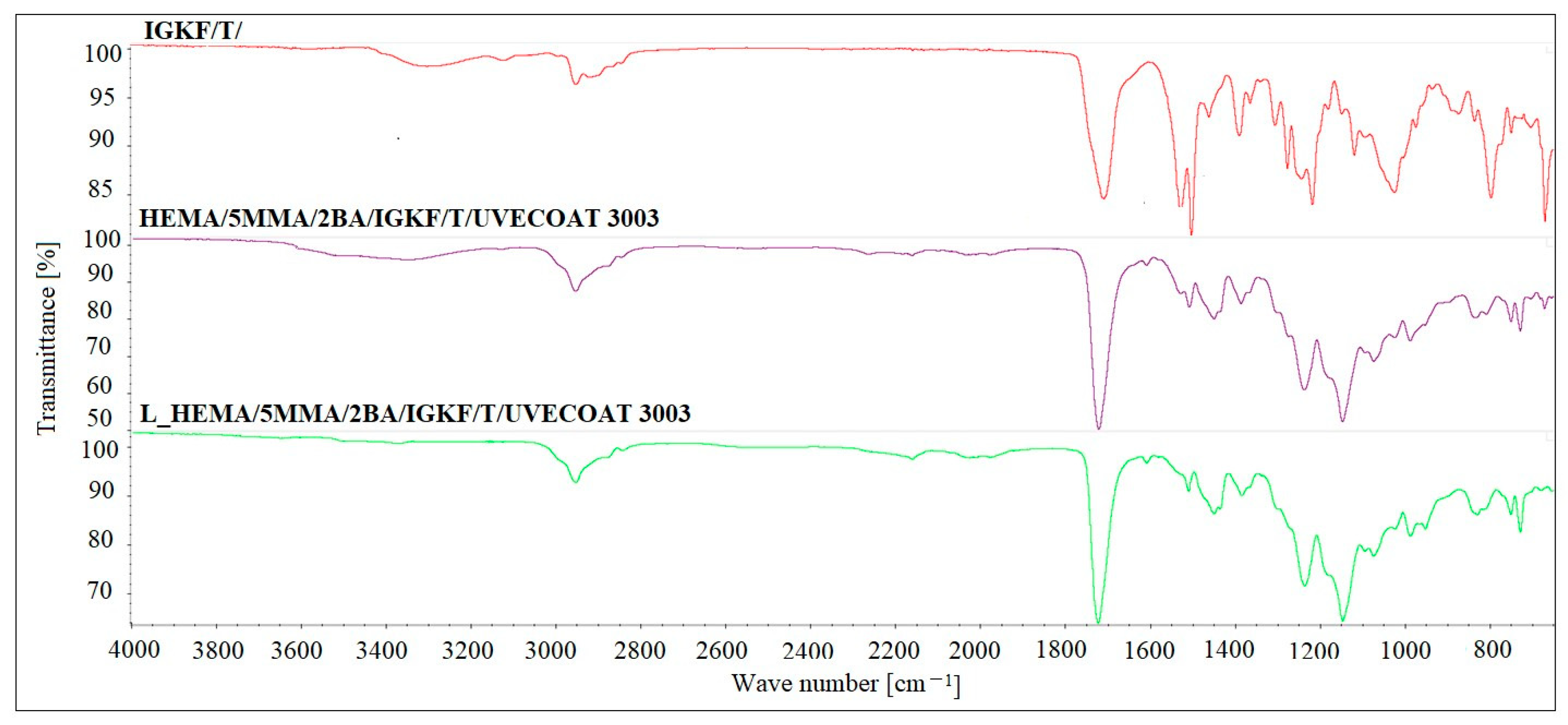
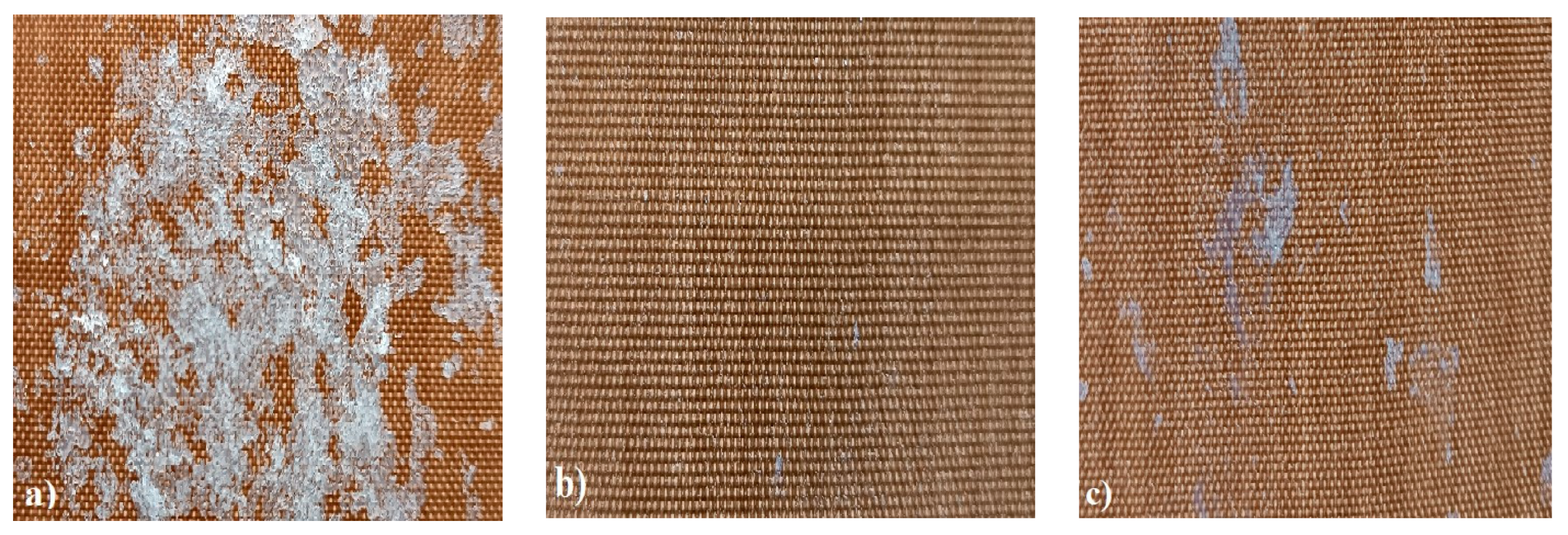

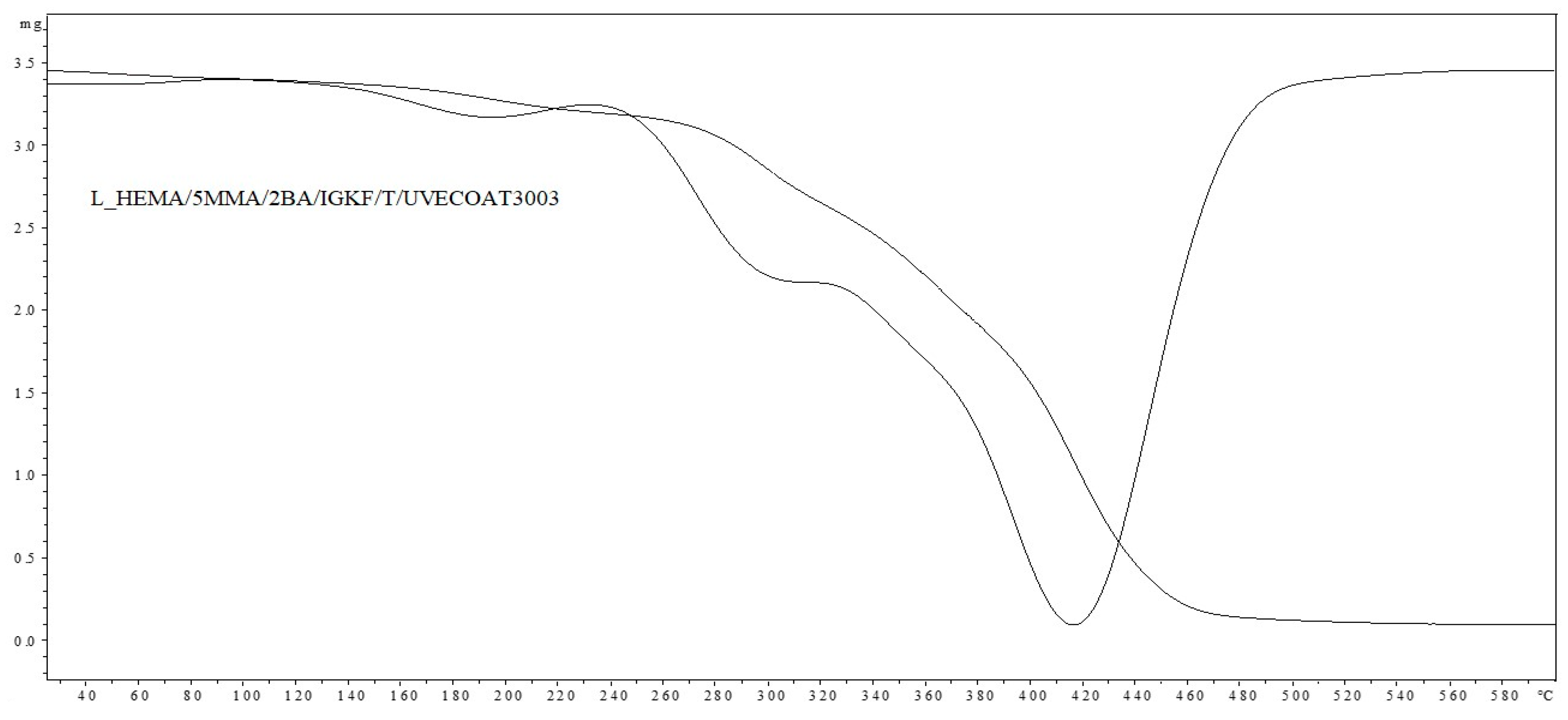
| Symbol of Powder Coating | HEMA/5MMA/2BA [%] | IGKF/T [%] | UVECOAT 3003 [%] |
|---|---|---|---|
| L_HEMA/5MMA/2BA/IGKF/T/ | 84.4 | 15.6 | - |
| L_HEMA/5MMA/2BA/IGKF/T/UVECOAT 3003 | 69.6 | 12.8 | 17.6 |
| Name of Sample | Room Temperature [23 °C] | Self-Healing Temperature [160 °C] |
|---|---|---|
| L_HEMA/5MMA/2BA/IGKF/T/ | 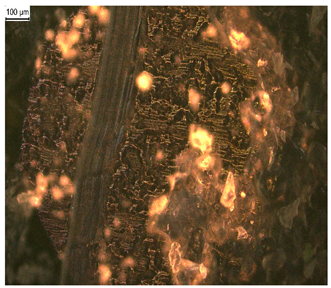 |  |
| L_HEMA/5MMA/2BA/IGKF/T/UVECOAT 3003 |  |  |
| Symbol of Coatings | L_HEMA/5MMA/2BA/IGKF/T/ | L_HEMA/5MMA/2BA/IGKF/T/ UVECOAT 3003 (After Curing) | L_HEMA/5MMA/2BA/IGKF/T/ UVECOAT 3003 (after Crack and Self-Healing Process) |
|---|---|---|---|
| Flowability [cm] | 1.10 | 1.25 | Not measured |
| Roughness: Ra/Rz | 4.9/12.8 | 1.5/8.0 | 4.3/14.35 |
| Gloss 60° [GU] | 30.36 | 37.86 | 27.26 |
| Thickness [um] | 56.85 | 68.74 | 65.86 |
| Relative hardness [-] | 0.54 | 0.73 | 0.47 |
| Adhesion to steel [0—good; 5—bad] | 2 | 1 | 3 |
| Scratch resistance [g] | 300 | 800 | 250 |
| Cupping [mm] | 4.6 | 4.5 | 1.2 |
| Water contact angle [deg] | 107.23 | 84.13 | 82.19 |
Disclaimer/Publisher’s Note: The statements, opinions and data contained in all publications are solely those of the individual author(s) and contributor(s) and not of MDPI and/or the editor(s). MDPI and/or the editor(s) disclaim responsibility for any injury to people or property resulting from any ideas, methods, instructions or products referred to in the content. |
© 2024 by the authors. Licensee MDPI, Basel, Switzerland. This article is an open access article distributed under the terms and conditions of the Creative Commons Attribution (CC BY) license (https://creativecommons.org/licenses/by/4.0/).
Share and Cite
Pojnar, K.; Pilch-Pitera, B.; Ataei, S.; Gazdowicz, P.; Mossety-Leszczak, B.; Grabowska, B.; Bobrowski, A. Self-Healing Thermal-Reversible Low-Temperature Polyurethane Powder Coating Based on Diels–Alder Reaction. Materials 2024, 17, 3555. https://doi.org/10.3390/ma17143555
Pojnar K, Pilch-Pitera B, Ataei S, Gazdowicz P, Mossety-Leszczak B, Grabowska B, Bobrowski A. Self-Healing Thermal-Reversible Low-Temperature Polyurethane Powder Coating Based on Diels–Alder Reaction. Materials. 2024; 17(14):3555. https://doi.org/10.3390/ma17143555
Chicago/Turabian StylePojnar, Katarzyna, Barbara Pilch-Pitera, Shahla Ataei, Patrycja Gazdowicz, Beata Mossety-Leszczak, Beata Grabowska, and Artur Bobrowski. 2024. "Self-Healing Thermal-Reversible Low-Temperature Polyurethane Powder Coating Based on Diels–Alder Reaction" Materials 17, no. 14: 3555. https://doi.org/10.3390/ma17143555
APA StylePojnar, K., Pilch-Pitera, B., Ataei, S., Gazdowicz, P., Mossety-Leszczak, B., Grabowska, B., & Bobrowski, A. (2024). Self-Healing Thermal-Reversible Low-Temperature Polyurethane Powder Coating Based on Diels–Alder Reaction. Materials, 17(14), 3555. https://doi.org/10.3390/ma17143555






